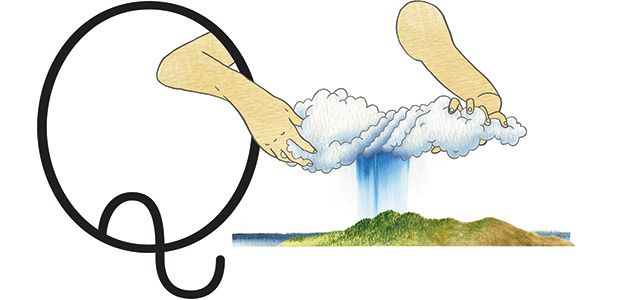How much water is in a cloud? What would be left if you squeezed the water out of it?
It depends on the cloud. A giant thunderhead may contain more than two billion pounds of water, but even a modest-sized cloud may contain water equivalent to the mass of a 747 jet. If you could squeeze the water out, the cloud would disappear. But you can’t. Some desert peoples use cloth “cloud catchers” to gather condensation and fill local water tanks for drinking and irrigation.
What is the practical use of the imaginary number √–-1?
The number is “imaginary” in the mathematical sense (that is, its square is less than zero). Such numbers represent solutions to many algebraic equations, and they are central to describing the motion of waves in such practical areas as hydrodynamics and aerodynamics, electrical circuit design, quantum mechanics and the theory of heat conduction.
Why did Roy Lichtenstein’s Cheese Head feature a slice of Swiss cheese as the subject’s head?
Lichtenstein was exploring Surrealist themes at the time (1977), and he may have been playing on The Son of Man, René Magritte’s famous 1964 portrait of a man with an apple all but covering his face. He may also have been making a joke when he replaced the head (brain) with Swiss cheese, but that’s speculation on my part.
At night I can see the entire Andromeda Galaxy with its center bulge of light. Why can’t I see the bulge of light at the center of our own galaxy, the Milky Way?
It’s because we view our galaxy from our solar system’s vantage point—that is, from within the galaxy. The center is very distant from us, and the space in between is filled with dust that obscures the bulge of stars associated with the galactic center. But we can see it with infrared light, which passes through the dust more easily.
Do any nonhuman animals exhibit homosexual behavior?
Yes; sex between animals of the same gender has been observed in hundreds of species, from penguins to guppies to bonobos, both in the wild and in captivity. In highly social species, individuals may exhibit same-sex sex if there’s a shortage of males or females. But researchers are still trying to determine why this behavior occurs, and they caution against using it to draw parallels between animals and humans.
Source: http://www.smithsonianmag.com/
Dear User/Visitor! Please, answer on our questions: tick off one of the positions – your answer will make us able to improve our site and make it more interesting and useful!


